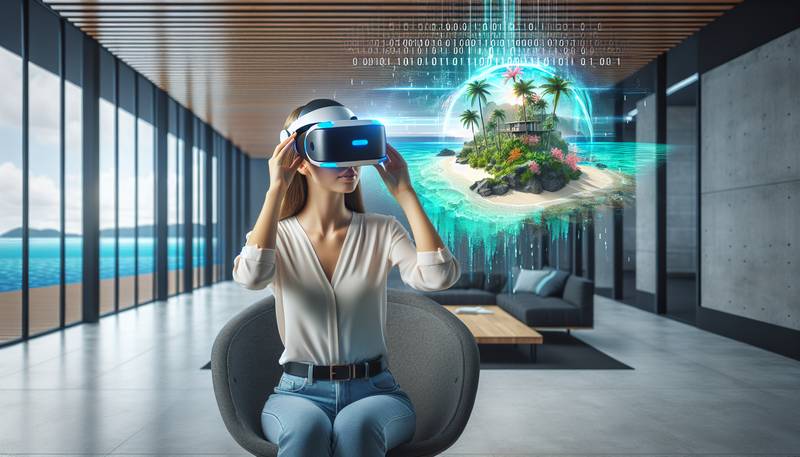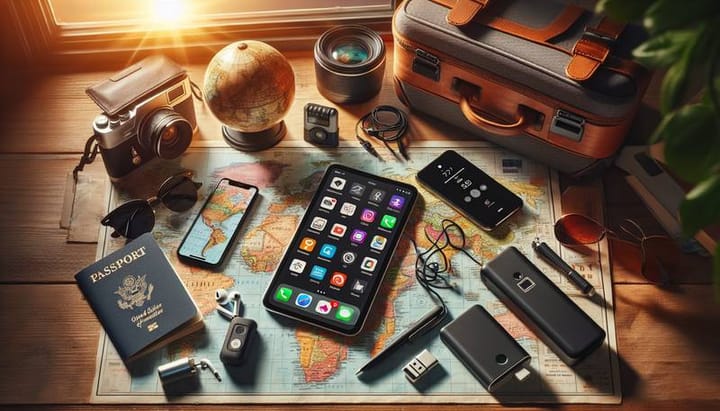Introduction to Virtual Reality (VR): Getting Started

Welcome to the fantastical world of Virtual Reality - a world where the lines between the real and the virtual blur, creating experiences that are as immersive as they are spectacular. Whether you're a hard-core gamer, a tech enthusiast, or just someone curious about this buzzword, this guide is your front-row ticket into the realm of VR. We'll cover all the basics - from understanding what VR is, to choosing the right system, and even getting set with essential accessories. By the end of this guide, you'll be more than ready to embark on your own virtual adventures!
What is Virtual Reality?
Imagine putting on a headset and suddenly being transported to a different world. You could be battling dragons, walking on the Moon, or exploring the depths of the ocean - all from the comfort of your home. This is the power of Virtual Reality. In technical terms, VR is an immersive multimedia or computer-simulated reality that replicates an environment that simulates a physical presence in places in the real or imagined worlds, allowing the user to interact in those worlds. It takes the form of a three-dimensional, computer-generated environment which can be explored and interacted with by a person. That person becomes part of this virtual world or is immersed within this environment and is able to manipulate objects or perform a series of actions.
How does it achieve such bewitchment? Through a combination of hardware, software and sensory synchrony. VR systems function by displaying stereoscopic images (slightly different images to each eye), which your brain interprets as three-dimensional. These systems also track your head and eye movements to ensure that the 3D world moves and reacts in real-time, just like it would in real life. Advanced systems even track hand movements or whether you're walking or jumping - the possibilities are endless! But, of course, VR isn't just for gaming. It has applications in fields as diverse as medicine, architecture, military, and education. It’s a testament to technology's limitless potential, and the future holds even more promises.
The Different Types of VR Systems
Not all VR systems are created equal. While they all seek to accomplish the same immersive experience, they go about it in different ways, catering to different needs, preferences, and wallets. The main types are tethered VR headsets, standalone VR headsets, and mobile VR headsets.
Tethered VR Headsets
Think of tethered VR headsets as the Ferraris of the VR world. They're designed to be connected to a separate device, such as a powerful PC or a gaming console like the PlayStation 4, via a physical cable - hence the name 'tethered'. This connection to a high-performance device means tethered headsets can deliver unparalleled visual fidelity and motion tracking. The likes of the Oculus Rift, HTC Vive, and PlayStation VR fall into this category. They offer a full range of movement - front, back, up, down, and all around - often with full body tracking.However, these top-tier experiences come not only at a higher price but also with additional considerations. For one, they require a lot of space - enough to walk around safely. You’ll need a dedicated play area clear of furniture and pets. They also necessitate a significant amount of setup, with external sensors or cameras needed for spatial tracking. And of course, there’s the issue of the tether - you'll always be physically connected to your PC or console, limiting true freedom of movement and requiring an awareness of the cable to avoid getting tangled or tripping during your immersive sessions.
Standalone VR Headsets
Welcome to the age of convenience with standalone VR headsets. If the tethered headsets are Ferraris, think of standalone headsets as the Teslas - smart, efficient, and no extra hardware needed. These all-in-one devices pack everything you need into the headset itself: the screen, the processors, the sensors, and the battery. This means you can take them anywhere and don't need to worry about pesky cables cramping your style.The Oculus Quest and the Google Daydream View are prime examples of this category. These headsets are generally less powerful than their tethered counterparts, but what they lack in sheer power, they make up for in convenience and ease of use. They’re perfect for someone new to VR, or for those who prioritize ease and portability. The trade-off, aside from lower performance, is battery life - since everything is contained within the headset, you'll be limited in how long you can play or work before needing a recharge. But for many, the trade-off is worth it for the ability to dive into VR quickly and easily, without a web of wires or an advanced degree in tech wizardry.
Mobile VR Headsets
Mobile VR headsets are the entry-level ticket into the world of virtual reality. These headsets use your smartphone as both the brains and the display of the operation, slotting in front of a pair of lenses within a headset frame. They're your passport to VR on a budget, with options like the Samsung Gear VR and the Google Cardboard leading the charge. User-friendliness is their hallmark - you need only pop your smartphone into the front, launch a VR app, and off you go into the virtual sunset.With mobile VR, there's no need for wires, no heavy hardware to carry around, and no need for a high-end computer. However, this ease comes at a cost. The VR experience is significantly less immersive compared to standalone and tethered headsets. The visual fidelity is dependent on your smartphone's screen resolution, and the motion tracking is less accurate. But if you're dipping your toes in VR waters for the first time or simply seeking a casual encounter with virtual space, mobile VR can be a suitable and budget-friendly starting point.
Getting Started with VR
Once you've decided on the kind of VR system that suits your needs best, it's time to take that exhilarating leap into the virtual. Setting up a VR headset may seem daunting, but fear not; manufacturers have gone to great lengths to make the process as simple as possible. Typically, you will download the VR platform's software onto your PC or plug the headset into your console, follow the on-screen instructions to calibrate your headset and sensors if needed, and complete any firmware updates. After this initial setup, your virtual journey is poised to begin. Always ensure your play area is clear and spacious enough to avoid collisions and accidents. With mobile and standalone VR, this is pretty straightforward. But with tethered headsets, you'll want to ensure that your wires are arranged to give you maximum movement without tripping over. Cable management solutions, like overhead pulley systems, can be a fantastic investment here. With everything set up, calibration fine-tuned, and play space secured, you're primed for a deep dive into the oceans of virtual reality.
Essential VR Accessories
Your VR headset is just the cornerstone of a building that can be endlessly built upon. To fully flesh out your VR experience, consider some of the numerous accessories available. A good pair of headphones can envelop you in rich audio, adding an incredible layer of immersion. Tracking sensors and cameras can enhance motion capture, allowing for more precise and fluid movements within the VR space. Hand-held controllers, like the Oculus Touch or the Valve Index controllers, can bring your hands into the VR realm, allowing for natural interaction with your virtual environment.Further still, haptic feedback devices like vests and gloves can transmit the sense of touch - imagine feeling the recoil of a blaster or the flutter of bird wings as they whisk by! There's an ever-expanding arsenal of VR gear, each designed to refine and enhance your journey into virtuality. Bear in mind that the need for such accessories will depend on the system you're using and the types of experiences you seek.
VR Content and Experiences
With your VR system primed and ready, it's time to explore the vast and ever-growing library of VR content. The fantastic thing about VR is the diversity of experiences readily available. For gamers, VR brings an unprecedented level of immersion to their virtual quests and battles. But beyond gaming, the virtual world beckons with educational adventures through space and time, through the human body, or into the delicate workings of machinery.Artists and creators can sculpt and paint in 3D space, designers and architects can walk through their buildings before they're built, and virtual tourism can whisk you away to places around the globe without leaving your home. The potential is boundless - from the deep sea to the high skies, the world of VR carries with it the promise of endless exploration and discovery.
VR Safety and Etiquette
Losing yourself in virtual worlds can be exhilarating, but it's essential to remember VR is a powerful technology that requires awareness and consideration. Always adhere to the safety guidelines set out by your headset manufacturer. That means taking breaks to prevent VR fatigue, using wrist straps to prevent controllers from flying across the room, and maintaining a safe play area to prevent real-world bumps and bruises.Equally, remember that VR is a shared frontier. If participating in online VR spaces, maintain a level of respect and decorum just as you would in "real" life. The immersive nature of VR means people can feel especially vulnerable, so it's crucial to heed others' comfort and personal space. With great power comes great responsibility - and that’s as true in virtual worlds as it is anywhere else.
Conclusion
Congratulations! You're now equipped with the foundational knowledge to jump into the world of virtual reality. VR is a transformative technology that's moved from the realms of science fiction into our daily lives, and it's just getting started. The potential applications are only limited by our imagination. Gaming, education, healthcare, art, and communication - all these fields and more are being revolutionized by the power of virtual reality.Remember, VR is much more than an escape - it's a new way of experiencing, creating, and interacting. As you embark on your VR adventure, keep an open mind, embrace the possibilities, and tread the virtual spaces with respect and curiosity. Welcome to the future - a future that's ready for you to shape it. Have fun, explorer of virtual horizons!


